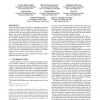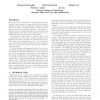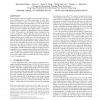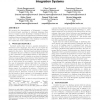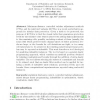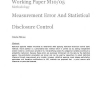SIGMOD
2010
ACM
14 years 11 months ago
2010
ACM
Virtually all histograms store for each bucket the number of distinct values it contains and their average frequency. In this paper, we question this paradigm. We start out by inv...
104
Voted
PVLDB
2010
14 years 11 months ago
2010
Commercial databases compete for market share, which is composed of not only net-new sales to those purchasing a database for the first time, but also competitive “win-backs”...
91
Voted
PVLDB
2010
14 years 11 months ago
2010
To evaluate the performance of database applications and DBMSs, we usually execute workloads of queries on generated databases of different sizes and measure the response time. Th...
PVLDB
2010
14 years 11 months ago
2010
This demonstration presents QueRIE, a recommender system that supports interactive database exploration. This system aims at assisting non-expert users of scientific databases by...
87
Voted
PVLDB
2010
14 years 11 months ago
2010
We propose the k-representative regret minimization query (k-regret) as an operation to support multi-criteria decision making. Like top-k, the k-regret query assumes that users h...
97
Voted
PVLDB
2010
14 years 11 months ago
2010
Data ambiguity is inherent in applications such as data integration, location-based services, and sensor monitoring. In many situations, it is possible to “clean”, or remove, ...
PVLDB
2010
14 years 11 months ago
2010
We propose the demonstration of Keymantic, a system for keyword-based searching in relational databases that does not require a-priori knowledge of instances held in a database. I...
PSD
2010
Springer
14 years 11 months ago
2010
Springer
Recently Sarathy and Muralidhar (2009) provided the first attempt at illustrating the implementation of differential privacy for numerical data. In this paper, we attempt to provid...
99
Voted
PSD
2010
Springer
14 years 11 months ago
2010
Springer
Minimum-distance controlled tabular adjustment methods (CTA), and its restricted variants (RCTA), is a recent perturbative approach for tabular data protection. Given a table to be...
102
Voted
PSD
2010
Springer
14 years 11 months ago
2010
Springer
Statistical agencies release microdata to researchers after applying statistical disclosure control (SDC) methods. Noise addition is a perturbative SDC method which is carried out...

